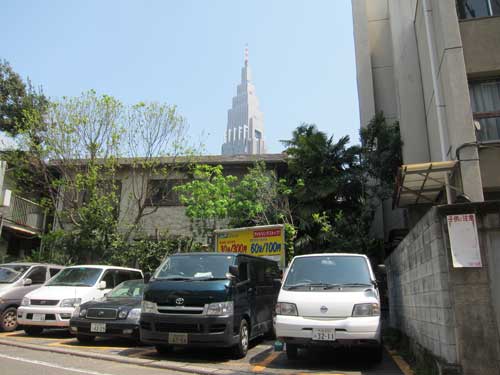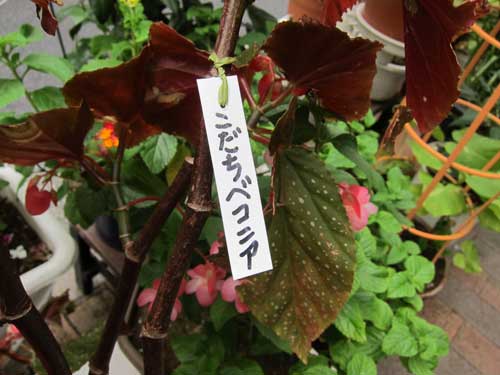
love
Launching Social Models, a design research studio in Tokyo & San Francisco
Tokyo Green Spaceと平行して、私が関わっている仕事を紹介させてください。デザイン人類学者として、コンサルティングをしています。会社名は、SOCIAL MODELS「ソーシャル・モデルズ」。クライアントの多くが企業・大学・芸術機関です。最新のホームページを立ち上げました。東京とヨーロッパで活躍するデザイナー、ルイス・メンドにデザインしてもらいました。ホームページには、リサーチの視点が写真と一緒に紹介されています。是非、寄ってください!
As many of you know, my “day job” is as a design anthropologist working with corporations, universities, and arts organizations. Recently, I re-formed my thirteen year consulting company as Social Models. Thanks to the amazing designer, Tokyo resident Luis Mendo, the new site’s images combine my love of photography and offbeat urban stories to show how design research rests on close observation and makes new opportunities visible. I can’t thank Luis enough for his skills at helping me communicate my passion for research and design in Tokyo and San Francisco.
I mistook this rampant winter “crow’s cucumber” for passion fruit
I love fuchsias, especially unusual ones
This “value net” can be used on land and in creeks to capture insects and small creatures
Which hydrangea do you like best? I love all types.

6月の梅雨で、一番きれいな花はアジサイでしょうか。色と種類が多いですが、僕は全部、大好きです。最近、伊豆の小さな田んぼのよこで、アジサイが咲いていたのを見ました。
I love all types of hydrangea. They are always so oversized, and particularly well suited to Japan’s rainy season. I like the elegant ones that bloom more sparingly, and also the giant pom pom types that come in so many different shades. Recently we saw hydrangea planted on the border of small rice fields in Izu.

Tanuki says, Be a Good Neighbor

タヌキさんは仲よくしようと言っています。喧嘩より、どんなかたちでもいいから、愛情のほうがいいと思います。イラストは天才Luis Mendoさんのです。
Why fight over barren islands? Why dream of racial purity and long-gone patriarchy? Why resist the urge to get to know each other?
Another brilliant tanuki poster from Luis Mendo. In a time of rising conflict between Japan and its closest neighbors, tanuki offers his enormous balls as a physical bridge and shared space for international, inter-species, and multi-sexual dancing and frolicking.
It’s time for truth, reconciliation, and love!
Tanuki Party campaign posters are already appearing everywhere

今どこでもタヌキ党のポスターが見えます。鎖国のより、愛を。
Spotted yesterday in Tokyo. This new Tanuki Party offers more love, less isolation.
Vote Tanuki Party, for next leader of Japan
Urban layers with wild space in the middle of Tokyo

この代々木の写真には、風景が3つ見えます。この組み合わせはとても東京らしいです。
This image sums up my love of Tokyo green spaces. In the background is the iconic Docomo Tower in Shinjuku. In the foreground is a typical Tokyo sight: a lot where the old structure has been raised is now used for hourly parking. In the middle is an older residence whose wild garden is thriving through neglect and the absence of redevelopment. Tokyo is a dense place full of the iconic and prosaic, living nature and concrete structures, traces of the past and constant change.
Elaborate sidewalk garden includes plant labels and stools

This Shinjuku ni-chome sidewalk garden is exceptional in its size, care, and labeling. The gardener lives in a former shop in an old building on what is now a busy entertainment district. From the sidewalk, you can see what appears to be merchandise, t-shirts and a few dress shirts, in the front room open to the street.

The gardener and his wife are often visible in the inner room which is partly visible. This type of retail/residential architecture is very Tokyo mid-century, and there are examples in many neighborhoods of former shop owners living in these spaces, some with remnants of their former businesses.

What I love about this sidewalk garden is the gardener’s obvious care and attention to creating a display of many plants. Nearly all of the pots rests on stools or low tables, with the highest ones closest to the road and the lower ones facing pedestrians on the sidewalk.

I am also amazed that the plants are all labeled, even the most obvious ones such as “rose” (バラ). I asked the older man why he labeled them, and he said that people often ask him and he doesn’t always remember the plant name.

The other amazing thing about the garden is just how big it is. There is easily more than one hundred plants. In addition to cover five meters or more in front of his building and his neighbors, he also expanded to an equally large area across the street. He is often outside watering and taking care of the plants.

I admire this gardener’s love for plants, his colonizing public space, and adding beauty in a crowded neighborhood.
Summer vegetables growing on the sidewalk

Walking down a large boulevard in Higashi Koenji, I was surprised to see these potted vegetables on the sidewalk. In addition to ginko trees, this street has many azaleas between the vehicle lanes and the pedestrian sidewalk. In this spot, there’s a semi-permanent row of pots. But these eggplants and tomatoes are an extra row that someone temporarily set up.

I love how seasonal and impromptu this vegetable gardening is. And, after almost two years in Japan, I am still startled that people can place plants they love on the street, and no one eats the vegetables, vandalizes, or steals the plants. A city that’s safe for vegetables and plants is one that also welcomes people.
Onbashira Festival in Suwa

I am still pondering last weekend’s trip to the Onbashira (御柱祭) festival in Suwa. It was surprising to see that this uniquely Japanese event has been picked up by the San Francisco Chronicle newspaper website and the Sacramento Bee (check them out for much better photos than mine). I also defer to Wikipedia for explaining the two and half month series of events, from cutting the trees with special axes, to riding the logs down a steep hillside, to erecting them at the shrines.
One amazing fact is that this festival has been going on for 1,200 years.

Some of my observations:
1. I wrote earlier about this unusual mix of animism, forestry, and virility. Animism because of the care and respect for the trees as sacred objects. Forestry because of the tremendous skills in cutting the trees and the long tradition of relying upon wood for buildings, fuel and paper. Virility because of the reckless riding of the logs, which often turn and injure the riders. This year there was a dislocated shoulder. In previous festivals, there have been deaths.
But while the log riding is considering the central activity, with large crowds and television coverage, the entire festival features seemingly impossible actions made more difficult by the rituals. Not only are the 20 meter logs carried through the hills and streets, but there are dozens of people standing on the logs which can only make the load heavier. Likewise, in photos showing how they lift the logs at the shrine to stand as vertical pillars, you can see that celebrants again stand on the logs as they are being lifted, adding more weight and danger.

2. In thinking about animism, forestry, and virility, I left out community. The entire series of rituals require hundreds and hundreds of participants, and thousands of spectators who are witnesses in person and through television sets. Hauling the logs are many teams of mostly men in traditional outfits, with different colored shirts marking sub-groups. The logs are tied with ropes and there must have been hundreds of people dragging them through the town. This image of community and exertion was perhaps more inspiring than the very rapid descent down the hillside.
3. There is also tremendous hospitality. Chigira, a young woman who has worked at Sinajina for several years, is from Suwa, and she meticulously organized our weekend. Siblings were marshaled to ferry our group of 11 from site to site, and her parents warmly welcomed us. We learned that weddings are avoided during festival years because the festival and the welcoming of guests is such a large expenditure for all the towns people.

4. While picniking and waiting to watch the log riding on the steep slope, Ito Hiromasa, the Executive Producer and Director of TEDxSeeds said hello to me. It was one of those realizations that Japan is a very small country, and that Onbashira Festival connects city and country people in a deep way. Ito-san also was impressed by the spirituality and mysteriousness of the event. He observed that the great care and hospitality show that the Suwa townspeople “love their culture, land, nature, ancestor and themselves.” These words and feelings seem uniquely Japanese, and I am still thinking about their meaning.

Article on Japan’s love of rice
My friend Alastair Townsend sent me a link to a great Economist article about rice farming in contemporary Japan: highlighting its spiritual dimensions and the challenges of rural abandonment.
Bonsai collection on residence wall

While many residences and business have common and inexpensive plants in public space or along the line dividing public and private, it is also amazing to see valuable plant collections on display outside homes and businesses. As an American, I am simply amazed that these labors of love and time are not destroyed or stolen.
Here’s two views of a residential home’s bonzai collection. I am taken by the gardener’s generosity and the public’s respect.






